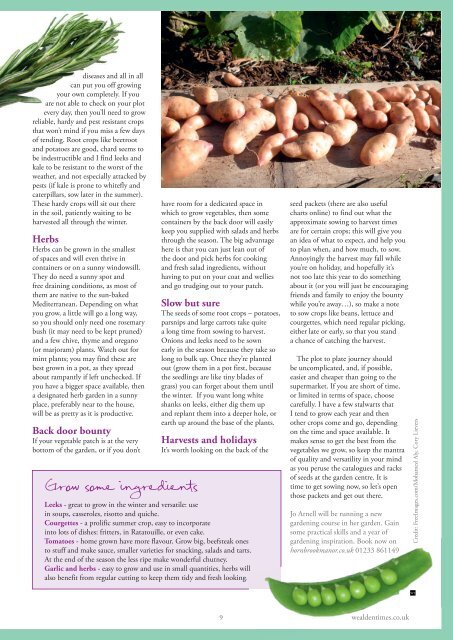Surrey Homes | SH30 | April 2017 |Gardens supplement inside
The lifestyle magazine for Surrey - Inspirational Interiors, Fabulous Fashion, Delicious Dishes
The lifestyle magazine for Surrey - Inspirational Interiors, Fabulous Fashion, Delicious Dishes
Create successful ePaper yourself
Turn your PDF publications into a flip-book with our unique Google optimized e-Paper software.
WT Garden Supplement<br />
diseases and all in all<br />
can put you off growing<br />
your own completely. If you<br />
are not able to check on your plot<br />
every day, then you’ll need to grow<br />
reliable, hardy and pest resistant crops<br />
that won’t mind if you miss a few days<br />
of tending. Root crops like beetroot<br />
and potatoes are good, chard seems to<br />
be indestructible and I find leeks and<br />
kale to be resistant to the worst of the<br />
weather, and not especially attacked by<br />
pests (if kale is prone to whitefly and<br />
caterpillars, sow later in the summer).<br />
These hardy crops will sit out there<br />
in the soil, patiently waiting to be<br />
harvested all through the winter.<br />
Herbs<br />
Herbs can be grown in the smallest<br />
of spaces and will even thrive in<br />
containers or on a sunny windowsill.<br />
They do need a sunny spot and<br />
free draining conditions, as most of<br />
them are native to the sun-baked<br />
Mediterranean. Depending on what<br />
you grow, a little will go a long way,<br />
so you should only need one rosemary<br />
bush (it may need to be kept pruned)<br />
and a few chive, thyme and oregano<br />
(or marjoram) plants. Watch out for<br />
mint plants; you may find these are<br />
best grown in a pot, as they spread<br />
about rampantly if left unchecked. If<br />
you have a bigger space available, then<br />
a designated herb garden in a sunny<br />
place, preferably near to the house,<br />
will be as pretty as it is productive.<br />
Back door bounty<br />
If your vegetable patch is at the very<br />
bottom of the garden, or if you don’t<br />
Grow some ingredients<br />
have room for a dedicated space in<br />
which to grow vegetables, then some<br />
containers by the back door will easily<br />
keep you supplied with salads and herbs<br />
through the season. The big advantage<br />
here is that you can just lean out of<br />
the door and pick herbs for cooking<br />
and fresh salad ingredients, without<br />
having to put on your coat and wellies<br />
and go trudging out to your patch.<br />
Slow but sure<br />
The seeds of some root crops – potatoes,<br />
parsnips and large carrots take quite<br />
a long time from sowing to harvest.<br />
Onions and leeks need to be sown<br />
early in the season because they take so<br />
long to bulk up. Once they’re planted<br />
out (grow them in a pot first, because<br />
the seedlings are like tiny blades of<br />
grass) you can forget about them until<br />
the winter. If you want long white<br />
shanks on leeks, either dig them up<br />
and replant them into a deeper hole, or<br />
earth up around the base of the plants.<br />
Harvests and holidays<br />
It’s worth looking on the back of the<br />
Leeks - great to grow in the winter and versatile: use<br />
in soups, casseroles, risotto and quiche.<br />
Courgettes - a prolific summer crop, easy to incorporate<br />
into lots of dishes: fritters, in Ratatouille, or even cake.<br />
tomatoes - home grown have more flavour. Grow big, beefsteak ones<br />
to stuff and make sauce, smaller varieties for snacking, salads and tarts.<br />
At the end of the season the less ripe make wonderful chutney.<br />
Garlic and herbs - easy to grow and use in small quantities, herbs will<br />
also benefit from regular cutting to keep them tidy and fresh looking.<br />
seed packets (there are also useful<br />
charts online) to find out what the<br />
approximate sowing to harvest times<br />
are for certain crops; this will give you<br />
an idea of what to expect, and help you<br />
to plan when, and how much, to sow.<br />
Annoyingly the harvest may fall while<br />
you’re on holiday, and hopefully it’s<br />
not too late this year to do something<br />
about it (or you will just be encouraging<br />
friends and family to enjoy the bounty<br />
while you’re away…), so make a note<br />
to sow crops like beans, lettuce and<br />
courgettes, which need regular picking,<br />
either late or early, so that you stand<br />
a chance of catching the harvest.<br />
The plot to plate journey should<br />
be uncomplicated, and, if possible,<br />
easier and cheaper than going to the<br />
supermarket. If you are short of time,<br />
or limited in terms of space, choose<br />
carefully. I have a few stalwarts that<br />
I tend to grow each year and then<br />
other crops come and go, depending<br />
on the time and space available. It<br />
makes sense to get the best from the<br />
vegetables we grow, so keep the mantra<br />
of quality and versatility in your mind<br />
as you peruse the catalogues and racks<br />
of seeds at the garden centre. It is<br />
time to get sowing now, so let’s open<br />
those packets and get out there.<br />
Jo Arnell will be running a new<br />
gardening course in her garden. Gain<br />
some practical skills and a year of<br />
gardening inspiration. Book now on<br />
hornbrookmanor.co.uk 01233 861149<br />
Credit: FreeImages.com/Mohamed Aly, Cory Lievers<br />
9 wealdentimes.co.uk


















